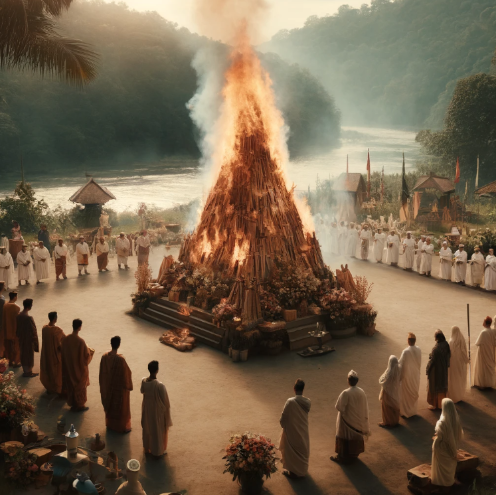As an officiant, you might have decided to include end of life ceremonies. For thousands of years, humans have burned our dead, but these days, it usually happens out of sight in a crematorium. This article explains where this modern practice comes from, and will help you understand how we used to send our deceased loved ones into the afterlife.
Throughout human history, funeral pyres have stood as one of the most profound and powerful ways to honor the dead. These blazing send-offs happen across many cultures and eras, from the ancient Hindus on the banks of the Ganges to the Viking warriors of the Scandinavian fjords.
A funeral pyre, a pile of wood built for the burning of a body, has rich cultural and religious symbolism. In many cultures, the act of burning the body is seen as a purification process, releasing the soul from the body and enabling it to move on to the next realm.
In Hinduism, one of the oldest religions in the world, the funeral pyre is the central part of the cremation ceremony. The fire is considered a purifier and a messenger, carrying the soul of the dead person to heaven. The body is placed on a carefully constructed pile of wood, and the eldest son or a close relative lights the fire. The ashes are later collected and scattered in a nearby river, symbolizing the return of the physical form to nature.
Similarly, in Viking culture, the funeral pyre was central to their funerary practices. Viking warriors were often cremated on pyres along with their possessions, which they would need in the afterlife. The fire symbolized both a farewell and a gateway to Valhalla, the majestic hall where they would join other fallen warriors in the afterlife.
Historically, funeral pyres have flared up across various civilizations. Each culture added their own customs to the practice.
In ancient Greece, cremation on funeral pyres became a common practice. The Iliad ( a famous Greek story) describes massive pyres built for heroes that died in battle. The Romans also adopted cremation and pyres. However, as the Roman Empire transitioned to Christianity, burial practices began to replace cremation.
In the Far East, particularly in Japan, the practice of cremation using funeral pyres comes from both Buddhist and Shinto traditions. Buddhism teaches that cremation releases the spirit from the body.
So what’s happening these days?
While modern cremation often takes place in an enclosed chamber, the symbolic essence of the funeral pyre remains, even if it’s hard to see. In India, funeral pyres are still used. In Nepal, the Pashupatinath Temple in Kathmandu is famous for its open-air cremations on the banks of the Bagmati River.
In Western societies, there’s been a renewed interest in alternative and eco-friendly funeral practices, including natural or green burials. While not identical to traditional pyres, these practices echo the ancient desire to return the body to nature in a meaningful and respectful way.
In modern funerary practices, the role of the officiant has evolved as well. Since online ordination has been available, many individuals now have the ability to perform more personalized end of life services. A close friend or family member is often better able to reflect the beliefs and wishes of the deceased and their family.
A funeral can also be a sensitive moment for those in attendance. Someone who is familiar with the family traditions and culture will also be able to hold a heartfelt and meaningful ceremony.
If, for legal or circumstantial reasons, a tradition such as lighting a funeral pyre is not an option (always check with local government and health officials regarding these matters) the officiant can still use symbolic elements such as a small flame and candle to create a meaningful experience.
Although we don’t see many of them here in the US, funeral pyres still capture our imagination. They represent a bridge between the earthly and the divine, and a final giving up the bodily form. While the physical act of cremation may have transformed, the essence of the funeral pyre lives on.
